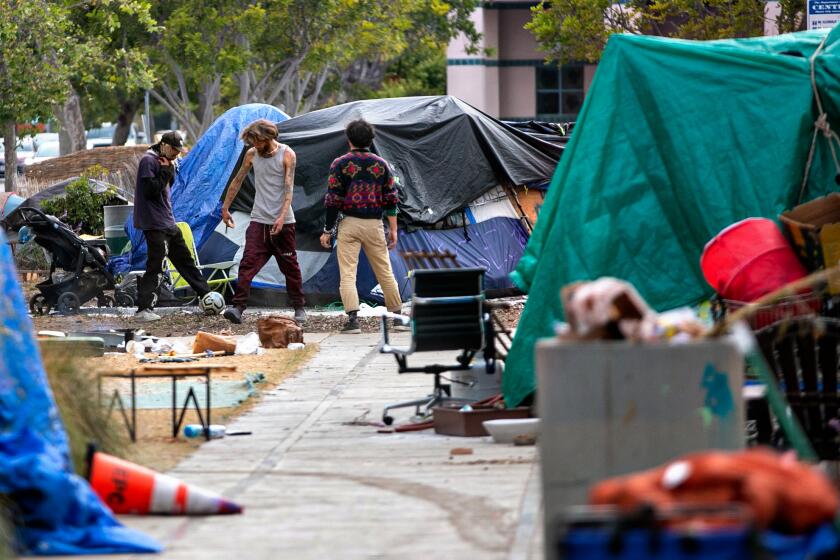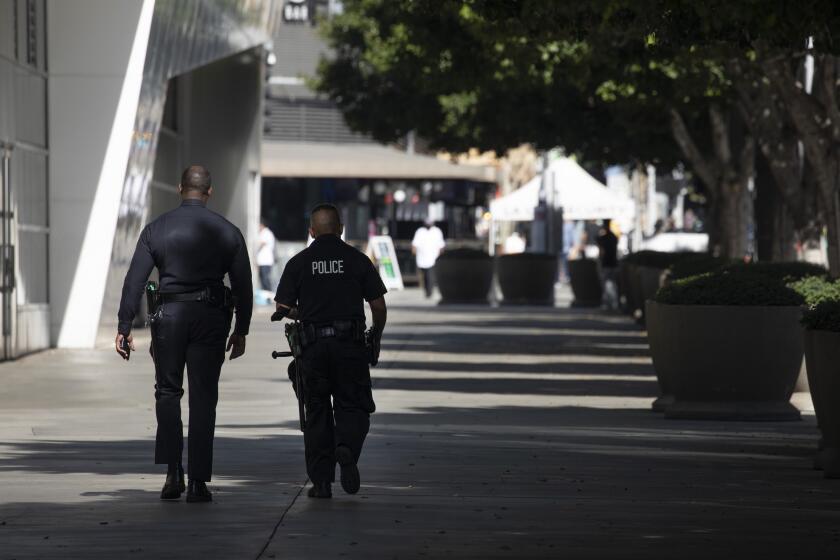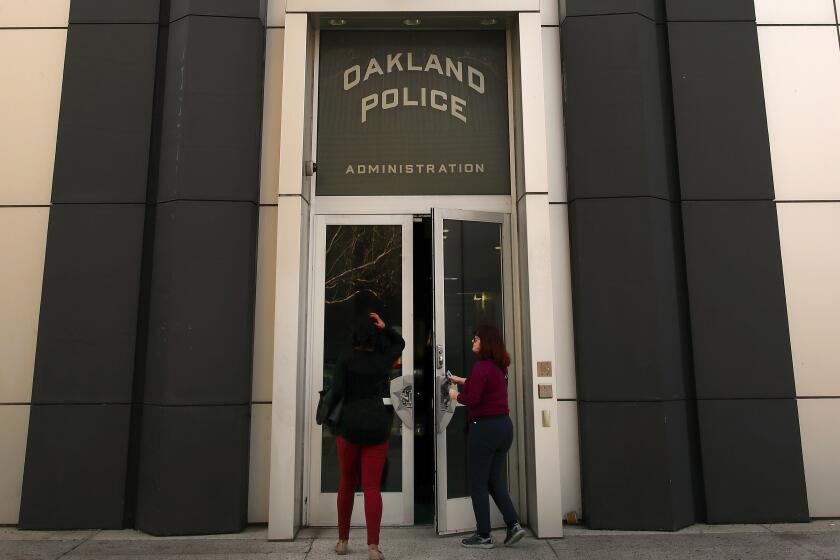Oakland police are doubling down on a tough-on-crime plan. Some activists are skeptical
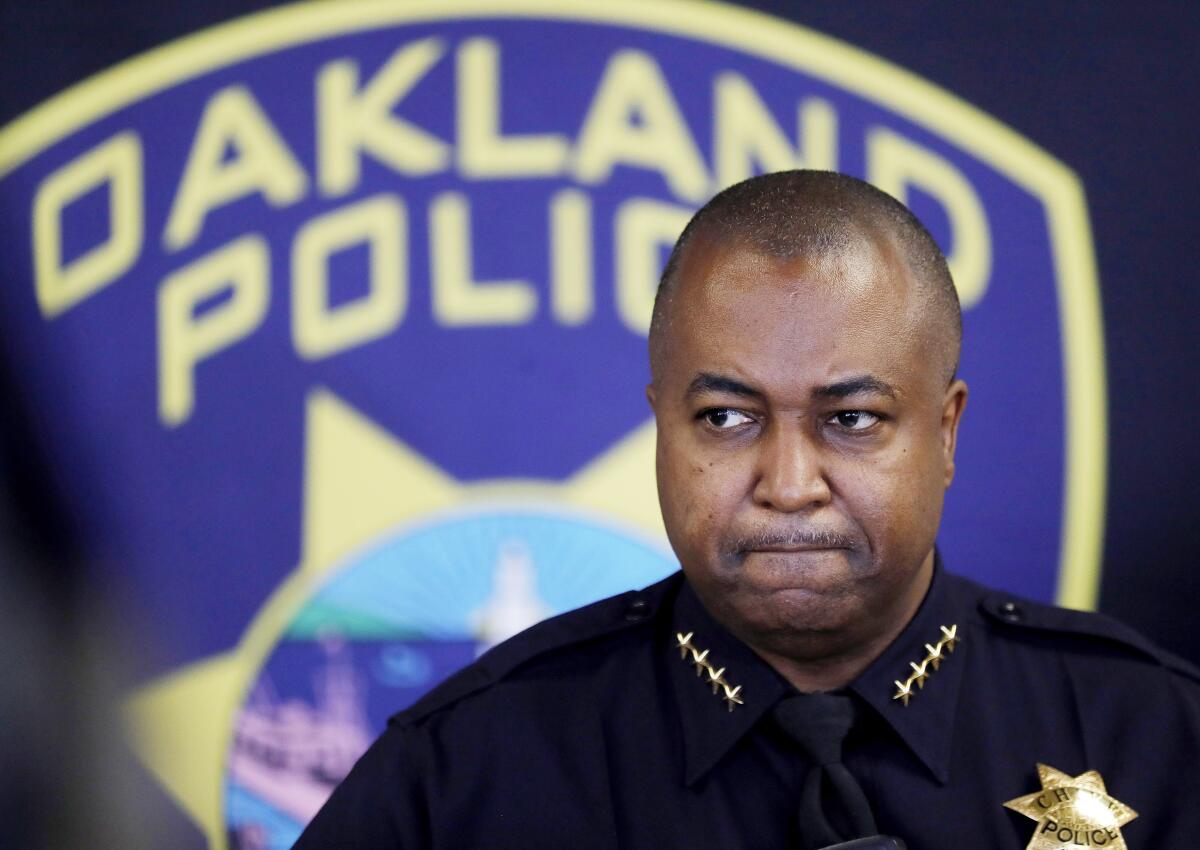
- Share via
It was late September, and to some, Oakland seemed a city on the brink.
Four people had been shot dead over a 24-hour span, including a shooting outside City Hall that briefly interrupted a council meeting.
By the end of the week, Oakland would record eight killings, marking the city’s deadliest seven-day stretch this year.
The following Tuesday, Sept. 27, Police Chief LeRonne Armstrong called an all-hands meeting and hatched a plan. Over the next four weeks, the department would deploy “all available resources throughout the city in a coordinated effort to enforce crimes associated with gun violence,” according to a news release.
Now police are doubling down.
In a news conference last week, Armstrong said what was initially a 30-day crime plan would be extended for another month.
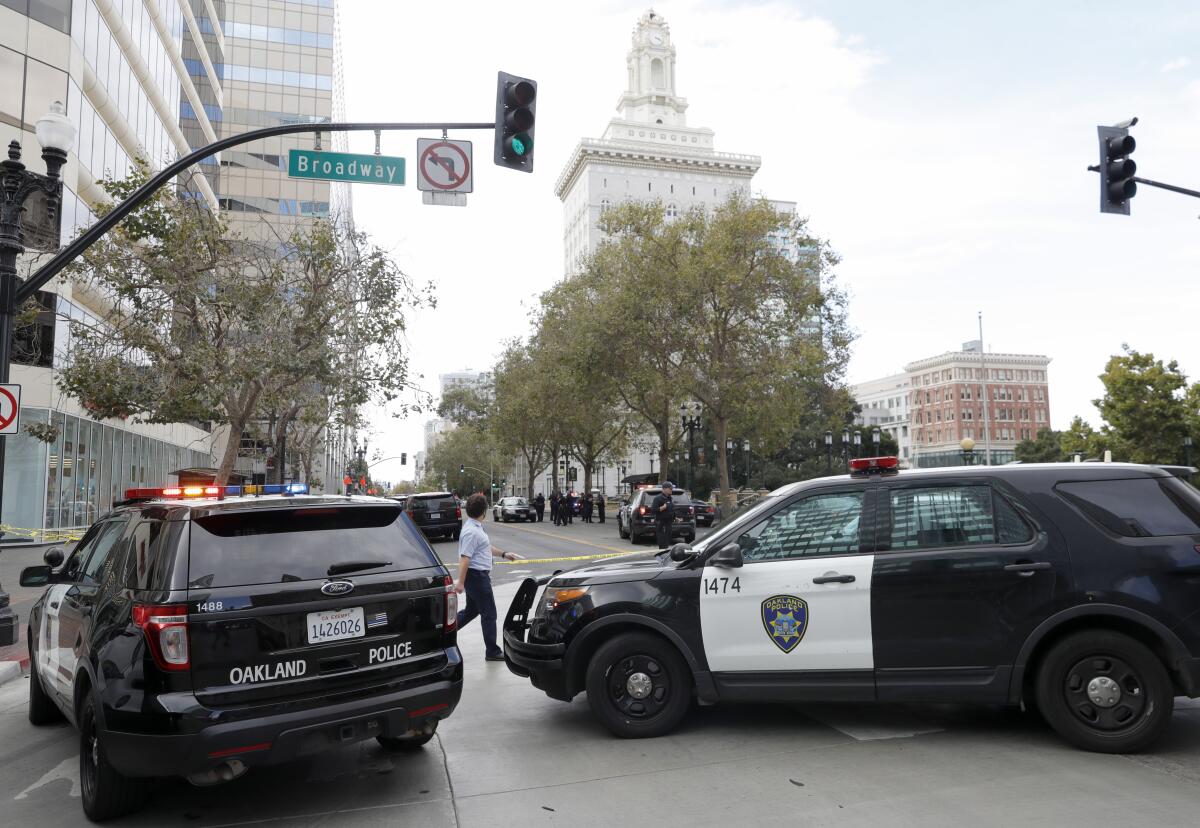
“I challenged my command staff to bring a different approach to addressing gun violence, with the goal of making an impact on public safety immediately,” he said. “I think just accepting the fact that we are going to have to arrest people, that when people commit violent crime in our city, we’re going to have to focus on apprehending them. … We’re going to [focus] on those individuals that continue to drive violence.”
But in a city whose Police Department has long been under federal oversight and struggled to regain the community’s trust, not all Oaklanders agree on whether the mobilization of “all available resources” is the right strategy.
“We should always be concerned when cops use words like ‘we are going to relentlessly pursue’ because that does lead to human rights violations,” said Cat Brooks, an Oakland activist, co-founder of the Anti Police-Terror Project and executive director of the Justice Teams Network.
A response to violent crime
The chief’s move came as homicides were on the rise in Oakland, according to a Times analysis of 10 years of Police Department data.
Last year, the city recorded 123 homicides, a 21% increase from 2020 and the most since 2012, when the total hit 126.
From 2013 through 2019, Oakland averaged 79 homicides a year.
As of Sunday, there were 105 homicides classified as murders in Oakland this year, according to Police Department data.
“What led to this initiative was a really deadly September,” Armstrong said of his initial 30-day plan. “The idea that we could have 17-some-odd homicides in one month was troubling for me and I’m sure was traumatic for our community.”
As deaths mounted, the chief said, police heard calls from the community for decisive action.
“I thought it was appropriate for us to be much more present in the community, not only through more officers out there but just being more aggressive when it came to focusing on those [individuals] that were driving gun violence,” he said.
Despite the small sample size, Armstrong said data show that his department’s recent initiative is helping.
Homicides and shootings fell by 47% and 33% respectively during the 30-day crime plan, according to the Police Department release announcing its extension. To date, homicides have fallen by 10% and shootings by 25% compared with the first 10 months of last year, according to the department.
Officers seized 80 guns and arrested 120 “very violent individuals” during the initial operation, police said.
For Brooks, the activist, it all boils down to political posturing by police.
She’s skeptical that there are any measurable results to the department’s all-out approach to stemming gun violence after one month.
“There’s not a data analyst on the planet who will tell you that you can say anything is trending in any direction based on 30 days of data,” Brooks said. “That’s not plausible.”
And despite the efforts laid out by Armstrong, Brooks described the Police Department’s relationship with the community as “horrific.”
The Oakland City Council has approved a proposal by Mayor Libby Schaaf to add two new police academies and unfreeze positions within the department.
“Rather than actually addressing the small percentage of the folks in any community here in Oakland that are actually engaging in violent acts, they’re too busy fighting us on preventing dollars going into things that actually prevent crime,” Brooks said, pointing to funding for housing and mental health services, which is dwarfed by police spending.
Armstrong, meanwhile, said collaboration with the community has been key to the Police Department’s strategy, pointing to the Ceasefire program, which was launched in late 2012.
The carrot-and-stick program championed by then-Mayor Jean Quan had shown promise in Philadelphia, Boston and Chicago. Individuals identified as responsible for violent crime were called in by community leaders, clergy and law enforcement and told to cease their activities and accept help rehabilitating — or suffer harsh consequences.
By the end of 2013 — a year in which a federal judge overseeing a decade-old settlement agreement over racial profiling and the beating and framing of suspects handed near-total control over the department to a compliance director — officials were declaring the program a success, citing a steep drop in violent crime.
Sean Whent, the interim police chief at the time and the fourth department head in as many years, credited the drop to Ceasefire’s targeting of East Oakland gangs that were engaging in tit-for-tat killings in their own neighborhoods, and heading to North Oakland and the city’s Lake Merritt district to pull off robberies.
The program remained effective because of its partnerships with the community and state and federal agencies, Armstrong told The Times last week. That changed when the pandemic hit in 2020, he said.
“I think it definitely had an impact on that strategy, the continuity of that strategy, and the way that we had been working for several years was disrupted,” he said.
Officers and violence prevention workers were not able to provide resources and support to break the cycle of gun violence, Armstrong said, adding that “zero-bail” releases due to COVID-19 contributed to the problem.
“You cannot address gun violence if there’s no accountability,” he said. “I think none of us were ready for a pandemic. It took a lot of time for all of us to adjust to that. How can we hold people accountable while understanding that we also are dealing with a deadly disease that we don’t want people held in custody for?”
Civil rights concerns
In addition to the increase in homicides over the last two years, the city has seen aggravated assaults rise from 2,536 incidents in 2017 to 3,559 in 2021, according to Oakland police data. Last year saw a 20% increase in aggravated assaults compared with the five-year average.
Robberies also increased from 2,610 in 2017 to 2,693 in 2021, the data show.
In all, violent crimes — homicides, rapes, robberies and aggravated assaults — rose from 5,466 in 2017 to 6,533 in 2021, according to the data. Last year’s total represented an 11% increase over the five-year average.
From the recall of San Francisco Dist. Atty. Chesa Boudin to the success of L.A. mayoral candidate Rick Caruso, playing into fears over crime and homelessness played well in Tuesday’s primaries. But will those concerns carry over to November?
The rise in violent crime has Oaklanders “overwhelmingly concerned,” according to an Oakland Chamber of Commerce poll released Oct. 19. The survey found that 97% of respondents called gun violence “an extremely or very serious problem, and 88% [said] the same about crime,” according to the San Francisco Chronicle.
Public officials and candidates in this month’s municipal election are latching on to the public safety concerns, Brooks said, adopting more traditional law-and-order stances and pushing for more police on the streets.
“We know that when people are desperate, tired and scared, we will sell our souls for the promise of safety,” she said. “But if history is to be repeated, which it always is, it will mean no more safety, more folks in prison and more brutality on our streets.”
Brooks was skeptical of assertions by Armstrong and other city officials that the Police Department is short on officers.
“There are only 15 less officers now than when [Mayor Libby Schaaf] took office, and the budget has increased every single year,” she said.
And between an academy class that graduated Friday and another coming in February, nearly 50 more officers are set to join the force. The Police Department was also recently awarded more than $1.8 million to hire 15 officers through a U.S. Department of Justice grant, Armstrong said.
In the coming weeks, officers will focus on taking firearms — untraceable “ghost guns” in particular, the chief said.
“We’ve got to get them off our streets,” he said during last week’s news conference. “We’ve seen them used in what we believe are really low-level crimes like the burglary of cars or the stealing of catalytic converters. All of them are producing gun violence.”
The bottom line, Armstrong said, is that Oaklanders need to feel like the Police Department is doing something to make the city safer.
While the L.A. mayoral race has been cast as an ideological showdown between Karen Bass, a progressive who’s willing to embrace alternatives to policing, and Rick Caruso, a more conservative law-and-order candidate, their views on public safety are not that different.
Central to that push is the use of so-called intelligence-led policing to focus on the small number of individuals who are driving gun violence, the chief said.
According to the Police Department, “30% of homicides and shootings are linked to group and gang conflicts.”
“It’s a focused effort,” Armstrong said. “It’s not about stopping everybody.”
The department has reduced overall stops by nearly 70% over the last five years, but officers need to make sure they’re stopping the right people, he said.
Meanwhile, the Oakland Police Department is still trying to end 19 years of federal oversight stemming from a settlement agreement in a class-action civil rights lawsuit against a group of officers known as “the Riders” who were accused of regularly beating, kidnapping and planting evidence against Black men.
That process recently hit a roadblock when U.S. District Judge William Orrick wrote in an Oct. 21 order that the Police Department was not cooperating with an outside law firm conducting two “serious” internal affairs investigations.
“The investigative outcomes may define the measure of the Department’s compliance with the sustainability period in general and to the processes of internal accountability in particular,” Orrick wrote.
After meeting 51 of 52 reforms set out by a settlement in 2003, the Oakland Police Department will go in front of a judge Wednesday to attempt to end its federal oversight.
Asked about the oversight and how the Oakland Police Department is working to ensure that its 30-day crime prevention strategy does not violate civil rights, Armstrong pointed to the five-year reduction in stops and said his officers are focused on the small number of people committing violent crimes.
“We’re highly focused,” he said. “I think the data supports that focus and we will continue to police in that way.”
But police need to address the rise in homicides, Armstrong said.
“We can’t ignore the fact that we’ve recovered over 80 guns in a 30-day period,” he said. “This community is living in fear, and so whether advocates sit on one side or another, I hope that we can all agree that Oakland is not [as] safe as it could be and there are far too many guns in our community.”
Officers, Armstrong said, are trying to bolster public safety while not infringing on those who aren’t involved in violent crime.
Brooks, meanwhile, points to history as a reason to distrust the police narrative.
During the 1980s and 1990s, the crack cocaine epidemic gave rise to a slew of tough-on-crime policies, including the 1994 crime bill and California’s “three strikes” law, she said.
“They convinced us that relentless law and order and policing of our communities was the only way it was going to get better,” Brooks said. “As a response, because we were desperate, Black folks were begging for the 1994 crime [bill]. We were begging for the three strikes law, and what happened? Our communities didn’t get any safer.”
More to Read
Sign up for Essential California
The most important California stories and recommendations in your inbox every morning.
You may occasionally receive promotional content from the Los Angeles Times.

